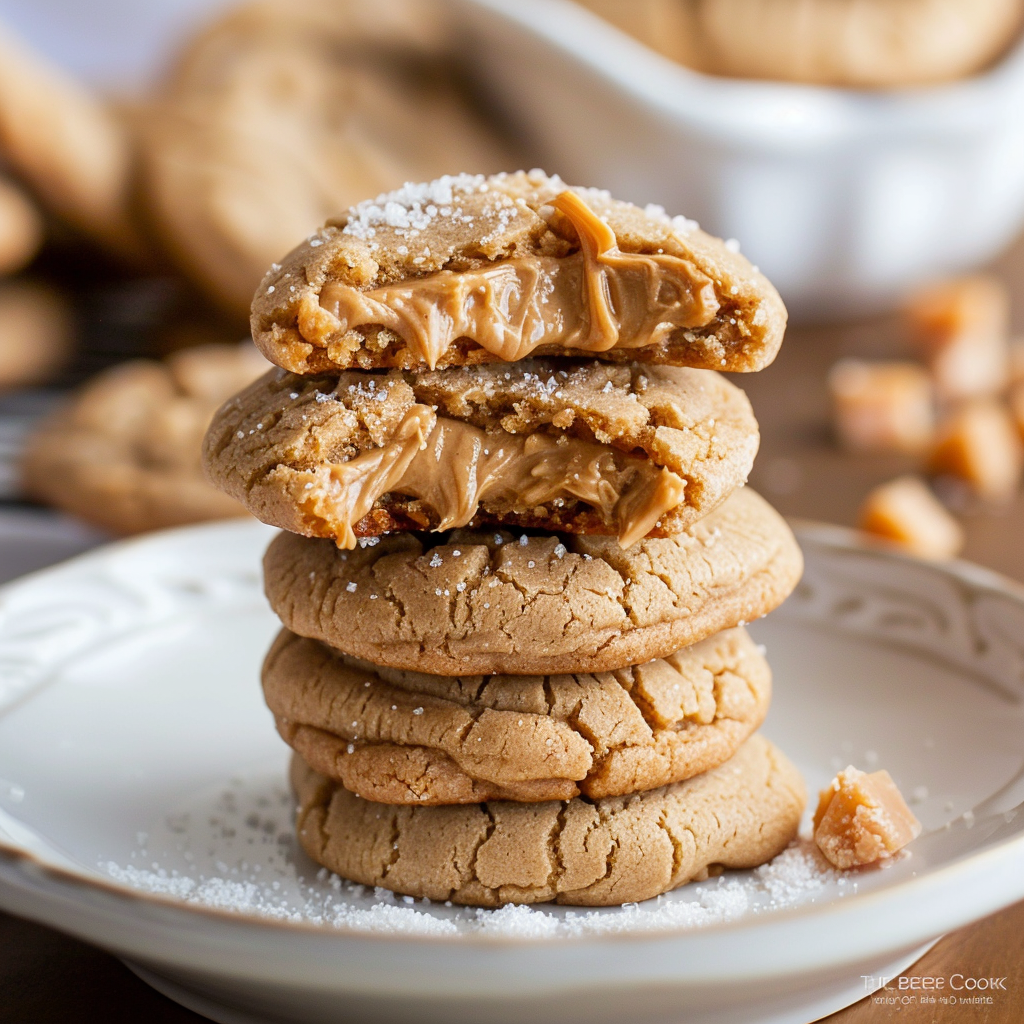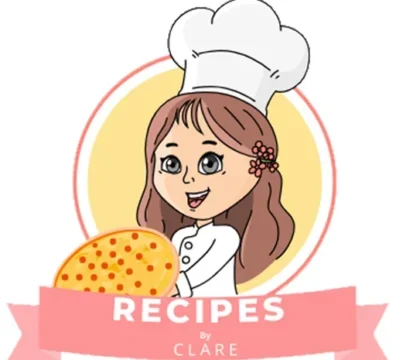Indulge in the ultimate treat with our decadent peanut butter cookies, featuring a surprise butterscotch truffle center that melts enticingly in your mouth. This recipe combines the rich, creamy textures of peanut butter and butterscotch to deliver a truly luxurious cookie experience perfect for any sweet tooth.
Ingredients:
Peanut Butter Truffle Filling:
- 1 cup butterscotch chips
- ¼ cup creamy peanut butter
Cookies:
- ½ cup unsalted butter, softened
- 1 cup creamy peanut butter
- 1 cup brown sugar
- 1 egg
- 1 teaspoon vanilla extract
- 1 ⅔ cups all-purpose flour
- 1 teaspoon baking soda
- ½ teaspoon salt
- ¼ cup granulated sugar (for rolling)
Directions:
Truffle Filling:
- Combine butterscotch chips and peanut butter in a microwave-safe bowl and melt in the microwave for 1 minute; stir until smooth.
- Chill the mixture in the refrigerator until it is thick enough to scoop, about 10-15 minutes.
- Scoop into tablespoon-sized balls and refrigerate until ready to use.
Cookie Dough:
- In a mixing bowl, cream together butter, peanut butter, and brown sugar until fluffy.
- Beat in the egg and vanilla extract.
- Gradually mix in the flour, baking soda, and salt until a cohesive dough forms.
Assemble Cookies:
- Place granulated sugar in a small bowl.
- Scoop about 2 tablespoons of cookie dough, flatten it, place a truffle ball in the center, and carefully enclose it with dough.
- Roll the filled dough ball in granulated sugar, then place on a prepared baking sheet and slightly flatten.
Bake:
- Preheat the oven to 350°F.
- Bake the cookies for 9-10 minutes until they are puffed and the edges are set.
- Allow the cookies to cool on the baking sheet for 10 minutes before transferring them to a wire rack.
Total Time:
- Prep Time: 45 minutes
- Cook Time: 10 minutes
- Total Time: 55 minutes
Nutritional Information:
- Calories: Approximately 300 kcal per cookie
FAQs:
Q: Can I use natural peanut butter for this recipe? A: For best results, use traditional creamy peanut butter as natural peanut butter may affect the texture and stability of the cookies and filling.
Q: How can I store these cookies? A: Store the cookies in an airtight container at room temperature for up to 3 days. For longer storage, you can refrigerate them for up to a week.
Q: What if I don’t have a microwave to melt the butterscotch chips? A: You can melt the butterscotch chips and peanut butter in a double boiler on the stove. Just make sure to stir constantly to prevent burning.
Q: Can I make the dough ahead of time? A: Yes, the cookie dough can be made ahead and stored in the refrigerator for up to 2 days. Just let it sit at room temperature for a few minutes to soften slightly before handling.
Chef’s Advice:
For an exceptional baking experience, always make sure your filling is chilled sufficiently before embedding it into the cookie dough; this helps maintain the integrity of the truffle center during baking. Additionally, avoid overbaking to ensure that your cookies remain delightfully soft and chewy in the center, with the perfect contrast of a slightly crisp exterior.
Embrace the art of baking with these gourmet peanut butter truffle cookies, and enjoy the burst of butterscotch as the highlight of your next dessert table!

Paragraph 1: The Art of Recipe Creation
Creating a recipe is an art form that blends culinary techniques with personal creativity. It involves selecting ingredients that not only taste good together but also complement each other’s textures and aromas. The process requires a deep understanding of flavor profiles and the effects of cooking methods on various ingredients, making recipe creation both a skill and an art.
Paragraph 2: Cultural Significance of Recipes
Recipes often carry significant cultural heritage, representing the history, traditions, and customs of a region. They serve as a gateway to understanding the societal norms and values of different cultures through the lens of food. Cooking traditional dishes is a way to keep history alive and share a piece of one’s heritage with others, making recipes more than just instructions for preparing food.
Paragraph 3: Recipes as a Bonding Tool
Cooking from a recipe can be a communal activity that brings people together. Families and friends gather in the kitchen, sharing the tasks of chopping, mixing, and cooking, which strengthens bonds and creates lasting memories. The kitchen becomes a place of laughter and storytelling, where relationships are nurtured and fortified over shared meals.
Paragraph 4: Recipes for Health and Wellness
Recipes also play a crucial role in health and wellness. By choosing ingredients that are nutritious and tailoring recipes to meet dietary needs, individuals can manage health conditions, improve overall well-being, and maintain a balanced diet. Cooking at home using wholesome recipes is a key step towards a healthier lifestyle.
Paragraph 5: Innovation Through Recipe Adaptation
Adapting recipes allows for innovation and personal expression in cooking. Chefs and home cooks alike experiment with substituting ingredients and techniques to create dishes that meet modern tastes and dietary restrictions. This evolution of recipes keeps the culinary world dynamic and exciting.
Paragraph 6: Educational Value of Recipes
Recipes are educational tools that teach more than just how to prepare a dish. They introduce novice cooks to culinary basics and offer seasoned chefs detailed insights into complex techniques and exotic ingredients. Through recipes, individuals learn about food science, nutrition, and the culinary arts.
Paragraph 7: Recipes as a Form of Entertainment
In today’s digital age, cooking shows and online recipe blogs have turned recipe preparation into entertainment. Watching skilled chefs prepare intricate dishes inspires viewers to try new recipes and learn cooking techniques, making the act of cooking a popular form of leisure and entertainment.
Paragraph 8: The Global Spread of Recipes
The internet has allowed recipes to travel beyond their geographic origins, introducing people all over the world to new cuisines. This global exchange of recipes fosters a greater understanding among cultures and brings a richer diversity of food to more tables, making culinary experiences more inclusive and varied.
Paragraph 9: Sustainability and Recipes
Recipes can also promote sustainability. By utilizing ingredients that are locally available, seasonal, and less commonly used parts of plants and animals, recipes can help reduce food waste and support local economies. Sustainable cooking practices contribute to a healthier planet and promote responsible consumption.
Conclusion
Recipes are much more than just a set of cooking instructions. They are a reflection of culture, a tool for social bonding, a vehicle for health and education, and a means of sustainable living. As we explore and share recipes, we participate in a global dialogue that celebrates diversity and fosters unity through the universal language of food. By embracing the full potential of recipes, we enrich our lives and contribute to a more interconnected and harmonious world.
